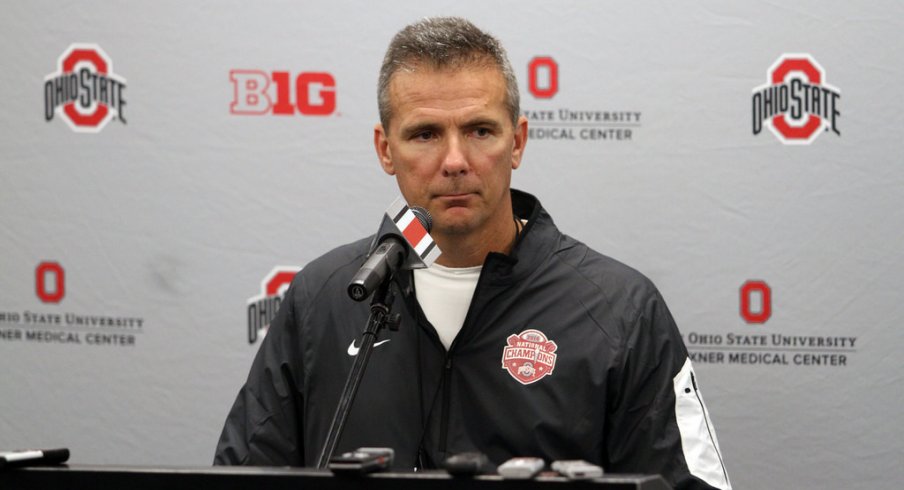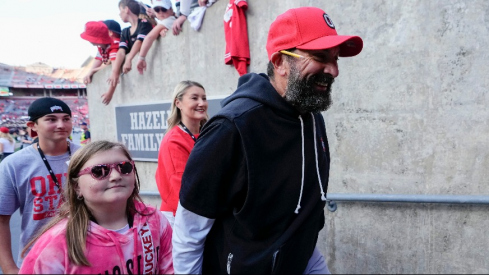With signing day now in the rear-view mirror and spring practice still a month away, it might seem like now is one of the easiest times to be a college football coach.
But just as their players are working hard in the weight room, coaching staffs across the country use this time of year to put in work behind closed doors in an attempt to get better.
Often times, coaches get credited for spending time with other staffs, bouncing ideas off one another in an effort to expand their knowledge base. Ohio State head coach Urban Meyer exercises this practice regularly, trading thoughts with his counterparts at the college level like Clemson and Oregon, as well as in the NFL with the New England Patriots.
Meyer adopted the zone-read after spending time with Rich Rodriguez in the early 2000s, showing the impact that such interactions can have. Yet these meetings often stay at a very high level, focusing more on why a staff might believe in a specific philosophy rather than how exactly to implement it.
Just as is the case in any field, there is always benefit to getting smarter and opening up to new ideas. However it's equally important to assess what you're already doing in an effort to understand how to get better, both as an organization and individually.
For football coaches, looking back at the details of how your team performed last fall can have dramatic impacts on the way you approach the upcoming season. Though every coach and every staff is different, the approach to scouting your own team the way you'd scout an opponent can have a major impact in three important areas: play-calling, practice time, and personnel.
Identifying your tendencies is the most basic method of self-scouting. In order to keep opponents guessing what you will do on the next play, you must first be aware of any trends or biases that may be evident to the competition.
These trends can take many forms. How often did the offense run the ball in a four receiver formation? How often did the defense blitz on first down?
To identify these trends, teams will chart every single play that is run during the season, based on the following criteria:
- Personnel package (such as 2-tight ends, 6 defensive backs, etc...)
- Down & distance
- Field position
- Formation
- Concept (such as Tight Zone, the Sail concept, or a specific blitz)
- Yards gained
This method of data collection was made famous by a long-time assistant coach and scout at the Naval Academy, Steve Belichick. While many think his greatest achievement in the game of football was raising his son, Bill, most coaches will argue that his 1962 book, 'Football Scouting Methods' was more impactful. In the book, Belichick explains how to chart the information listed above, and although some parts of the game have changed, his methods of identifying a team's tendencies are just as apt today as they were when the book was released.
Programs like Ohio State benefit from having multiple graduate assistants and other staff members that can do some of this dirty work, but the video departments and the databases they populate are often the real heroes of this operation. Technology like Hudl has allowed smaller colleges and high schools to catalogue and automate this process further, but the coach must be able to understand what information is worth identifying, and which trends or outliers deserve further analysis.
This information is most valuable to the coaches calling the plays live during games, and is often looked at during bye weeks while the season is underway. At this level, if an offense has run behind the left side on 3rd & short in each of the past few games, the defense will expect to see it again when they see the same scenario. The play-caller must take this into account when making his decision.
But in the offseason, these trends can expose a team's weaknesses and dependencies. Virginia Tech defensive coordinator Bud Foster famously shut down the Buckeyes in their 2014 meeting thanks to his aggressive 'Bear' front and man coverage, having seen how rarely the OSU offense threw deep on early downs under the existing coaching staff. Foster was able to recognize tendencies and use that to shape his game plan in a way that Meyer and his staff should have seen coming.
Every coach has philosophies, and Meyer's is leaning on a powerful zone-running game to open up play-action passes downfield. Knowing his tendencies won't change that fact. What they might change though, is the addition of deep passes down the seams or quick, three-step hitches and slants on the outside on first down to loosen up a pressing defense like the Hokies that night two years ago.
These additions will of course change the way the team allocates their practice time in spring and the pre-season training camps. Given the NCAA's limits on time players and coaches can work together, coaches must often remove something before they can add something new.
Once again, these self-scouting reports can play a key factor. If a team spent weeks in their spring camp installing and practicing a specific concept, only to notice that it wasn't leaned heavily upon once the regular season rolled around, then it's worth asking whether it should be de-prioritized in the future.
The same can be applied to the study of which concepts simply didn't work. Belichick's method of identifying patterns is much more powerful when a coach can insert the exact play-calls into the database.
For instance, the Buckeyes might notice this year that the Jet Sweep, which has been such a big part of Meyer's offenses for years, wasn't as successful on average as it was in the past. Does that mean coordinator Ed Warinner will remove it from the playbook? Probably not. But it does mean the play might not get introduced in Spring Practice until day three or four instead of day one.
Finally, the coaches need to evaluate how their existing tendencies may be affected by what personnel will be returning next season. For instance, the Buckeyes called an inordinately high number of short passes on the outside to Michael Thomas last year. With his departure to the NFL, can Noah Brown or Corey Smith step in and run the same routes with similar ability? If not, then the priority placed on those passing concepts should likely be de-emphasized, with different ones that will maximize Brown and Smith taking their place.
These patterns can also help identify areas for opportunity for those returning.
After running an exceptionally high amount of double-tight end formations with Nick Vannett and Marcus Baugh in 2015, Baugh will return as the only tight end with any experience in 2016. Knowing they will likely be running even more 11 personnel (1 running back, 1 tight end) in the fall, the staff will now look to call out what concepts worked the best when Baugh was the sole tight end on the field.
Perhaps more than any other aspect of their jobs, this process may be the least visible for football coaches. No one creates hype videos of them staring at spreadsheets or building practice plans alone in their offices.
But the results from the process are invaluable to a team come game day. Make no mistake, coaches grind too.


